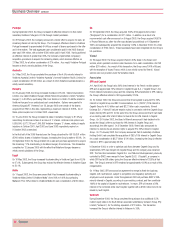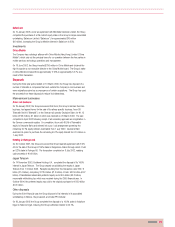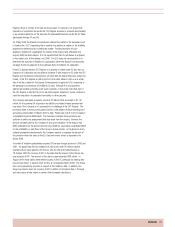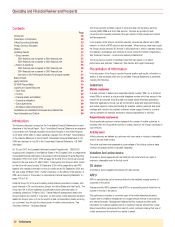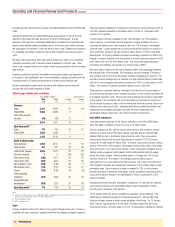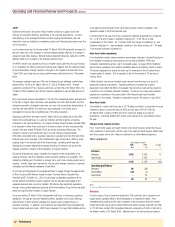Vodafone 2005 Annual Report Download - page 33
Download and view the complete annual report
Please find page 33 of the 2005 Vodafone annual report below. You can navigate through the pages in the report by either clicking on the pages listed below, or by using the keyword search tool below to find specific information within the annual report.
Performance |31
Cost capitalisation
Cost includes the total purchase price and labour costs associated with the Group’s
own employees to the extent that they are directly attributable to construction costs, or
where they comprise a proportion of a department directly engaged in the purchase or
installation of a fixed asset. Management judgement is involved in determining the
appropriate internal costs to capitalise and the amounts involved. For the year ended
31 March 2005, internal costs capitalised represented approximately 6% of
expenditure on tangible fixed assets and approximately 4% of total operating expenses,
excluding goodwill amortisation.
Impairment reviews
Asset recoverability is an area involving management judgement, requiring assessment
as to whether the carrying value of assets can be supported by the net present value of
future cash flows derived from such assets using cash flow projections which have
been discounted at an appropriate rate. In calculating the net present value of the
future cash flows, certain assumptions are required to be made in respect of highly
uncertain matters, as noted below.
UK GAAP requires management to undertake a review for impairment if events or
changes in circumstances indicate that the carrying amount of an asset may not be
recoverable. Group management currently undertakes a review of goodwill, intangible
assets and investments in associated undertakings at least annually to consider
whether a full impairment review is required.
US GAAP
Under US GAAP, the requirements differ from UK GAAP and the principal differences are:
•For finite-lived intangible assets and tangible assets, the carrying value is compared
to undiscounted future cash flows to determine if the asset or asset group is
recoverable. If the carrying value exceeds the undiscounted cash flows, the carrying
value is not recoverable and the asset or asset group is written down to the net
present value of future cash flows derived in a manner similar to UK GAAP.
•For the period to 31 December 2004, the recoverability of indefinite-lived intangible
fixed assets was assessed by comparing the carrying value to the fair value. The
fair value is determined by deducting the fair value of all other assets within a cash-
generating unit from the total fair value of that unit.
•On 1 January 2005, the Group adopted Emerging Issue Task Force (“EITF”) Topic
D-108. Under this standard, indefinite-lived intangibles assets other than goodwill
are now tested for impairment by comparing the carrying amount with the fair value
of the asset determined on a standalone basis. The cumulative effect on net loss of
adopting this standard was £6,177 million, net of related taxes of £5,239 million.
Assumptions
There are a number of assumptions and estimates involved in calculating the net
present value of future cash flows from the Group’s businesses including:
•Management’s expectations of growth in revenue, including those relating to the
achievement the Group’s strategy on data products and services;
•Changes in operating margin;
•Timing and quantum of future capital expenditure;
•Uncertainty of future technological developments;
•Long term growth rates; and
•The selection of discount rates to reflect the risks involved.
The Group prepares and internally approves formal ten-year plans for its businesses
and uses these as the basis for its impairment reviews. For periods beyond the
ten-year plans, forecast growth rates do not exceed nominal gross domestic product
(“GDP”) for mobile network operators, using forecast nominal GDP rates from external
sources, and are below nominal GDP for other businesses.
Changing the assumptions selected by management, in particular the discount rate and
growth rate assumptions used in the cash flow projections, could significantly affect the
Group’s results. The Group’s review includes the key assumptions related to sensitivity
in the cash flow projections.
Taxation
The Group’s tax charge on ordinary activities is the sum of the total current and
deferred tax charges. The calculation of the Group’s total tax charge necessarily
involves a degree of estimation and judgement in respect of certain items whose tax
treatment cannot be finally determined until a formal resolution has been reached with
the relevant tax authority or, as appropriate, through a formal legal process. The final
resolution of some of these items may give rise to material profit and loss and/or cash
flow variances. See “Liquidity and Capital Resources”.
The growth in complexity of the Group’s structure following its rapid expansion
geographically over the past few years has made the degree of estimation and
judgement more challenging. The resolution of issues is not always within the control
of the Group and it is often dependent on the efficiency of the legal processes in the
relevant taxing jurisdictions in which the Group operates. Issues can, and often do,
take many years to resolve. Payments in respect of tax liabilities for an accounting
period result from payments on account and on the final resolution of open items. As a
result, there can be substantial differences between the tax charge in the profit and
loss account and tax payments.
Recognition of deferred tax assets
The recognition of deferred tax assets is based upon whether it is more likely than not
that sufficient and suitable taxable profits will be available in the future, against which
the reversal of timing differences can be deducted. Recognition, therefore, involves
judgement regarding the future financial performance of the particular legal entity or
tax group in which the deferred tax asset has been recognised.
Historical differences between forecast and actual taxable profits have not resulted in
material adjustments to the recognition of deferred tax assets.
Non-discounting of deferred tax assets and liabilities
UK GAAP permits, and US GAAP prescribes, calculating deferred tax assets or liabilities
on an undiscounted basis. It is the Group’s accounting policy to measure deferred tax
on an undiscounted basis. If deferred tax liabilities were calculated using discounting
techniques, the Group’s UK GAAP net deferred tax liability would be lower.
Revenue recognition and presentation
Turnover from mobile telecommunications comprises amounts charged to customers in
respect of monthly access charges, airtime charges, messaging, the provision of other
mobile telecommunications services, including data services and information provision,
fees for connecting customers to a mobile network, revenue from the sale of equipment,
including handsets, and revenue arising from the Group’s Partner Network agreements.
Deferral period
Customer connection fees, when combined with related equipment revenue, in excess
of the fair value of the equipment are deferred and recognised over the expected life of
the customer relationship. The life is determined by reference to historical customer
churn rates. An increase in churn rates would reduce the customer relationship life
and accelerate revenue recognition. Historically, changes in churn rates have been
insufficient to impact the expected customer relationship life.
Any excess upgrade or tariff migration fees over the fair value of equipment provided
are deferred over the average upgrade or tariff migration period as appropriate. This
time period is calculated based on historical activity of customers who upgrade or



